A Visit to The Museum of London’s Sherlock Holmes Exhibit
When speaking about Sherlock Holmes, there are a few things that may immediately come to mind: Deerstalkers, brilliant deductions, moustachioed doctor turned biographer, the canonically inaccurate “Elementary, my dear Watson” and of course, London – the great city that is as much a part of the infamous detective as he is a part of it. Even now decades after his creation, Sherlock Holmes continues to inspire the minds and imaginations of fans all over the world.
The Museum of London has opened the first major Sherlock Holmes exhibit to be seen in London in the last 60 years. It comes at a time when Holmes mania is at an all-time high; thanks in large part to the recent adaptations such as the BBC’s Emmy and BAFTA award winning show Sherlock. For over 125 years the most iconic fictional Londoner has reached millions world wide and continues to draw in new fans year after year.
I was given the delightful honour to view the exhibition a day before it opened up to the general public, there I got to meet some members of press, many of whom were big Sherlock fans themselves. It was interesting to talk with them, most of the fans I interact with tend to be around my own age, so to converse with an older generation of Sherlockians was something different and brought up the question that is the thesis of the entire exhibit: Why have the characters Sherlock Holmes and his faithful Doctor Watson endured for so long?
Just before entering the exhibit there was a bit of playful mystery and dramatics, with a bookcase that amusingly puzzled a few people before it was revealed that with a little push, the bookcase would part down the middle, revealing the passage into the exhibit.
Immediately upon entering you see a massive mirror that reflects the large text on the parallel wall: Sherlock Holmes. Along that wall there are a series of tastefully arranged screens that present the many adaptions of Sir Arthur Conan Doyle’s work, from Elementary to Granada, the many faces of Holmes and Watson are laid out for us to see and be reminded just how withstanding these characters have been and the new directions they’re going now.
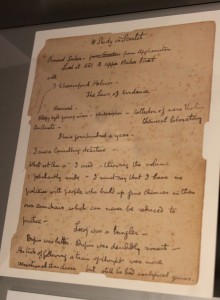 If you look away from the rather grandiose entrance display you’ll see the next section aptly titled ‘The Genesis of Sherlock Holmes’, there you’ll find something that for any Sherlockian, is a rare and glorious sight to behold. Admittedly, this was the one thing I had been looking forward to the most, because on this delicate bit of paper were two names: Sherrinford Holmes and Ormond Sacker, whom would later be known to the world as Sherlock Holmes and Doctor John Watson. It was the 1886 manuscript notes for ‘A Study in Scarlet’ previously written as ‘A Tangled Skein’.
If you look away from the rather grandiose entrance display you’ll see the next section aptly titled ‘The Genesis of Sherlock Holmes’, there you’ll find something that for any Sherlockian, is a rare and glorious sight to behold. Admittedly, this was the one thing I had been looking forward to the most, because on this delicate bit of paper were two names: Sherrinford Holmes and Ormond Sacker, whom would later be known to the world as Sherlock Holmes and Doctor John Watson. It was the 1886 manuscript notes for ‘A Study in Scarlet’ previously written as ‘A Tangled Skein’.
Fun fact: “A tangled skein” is an old expression to describe murder, mystery and drama. Pretty much Holmes in a nutshell, right?
Beside it was the Southsea notebook, written in about 1885-1886 during a time when Conan Doyle was practicing medicine in the Southsea area, thus the notebooks name. It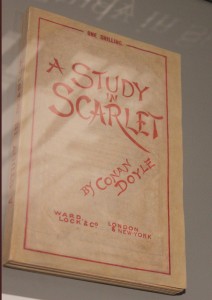 is one of three on display that Conan Doyle first wrote his ideas and fleshed out the details of not only Holmes, but of his other lesser known stories. It was something special to be able to see a seemingly ordinary of books and a leaf of paper that all contain such a poignant piece of history, not only for fans but for literature as we know it.
is one of three on display that Conan Doyle first wrote his ideas and fleshed out the details of not only Holmes, but of his other lesser known stories. It was something special to be able to see a seemingly ordinary of books and a leaf of paper that all contain such a poignant piece of history, not only for fans but for literature as we know it.
I lingered there for a while, because the literary nerd in me demanded it, but as I continued on I came across a few other delights. The whole exhibit is divided into sections, which all aim to help you understand the crazy mad genius of this fictional detective, but also pay homage to the many, many adaptions out there. Some of the highlights include film posters ranging from the 1905 film Sherlock Holmes, 1924’s The Sign of Four and 1959’s The Hound of Baskervilles to the 2009 Chinese version of Guy Richie’s Sherlock Holmes poster.
Alongside a rather dashing portrait of the great author himself (who we all know was staring at us with a great deal of disdain and a gaze that practically screamed ‘I’d kill him again if only it meant you would remember me for something else!’), painted soon after he had killed off Holmes in 1893, were the original illustrations by Sidney Paget. These etchings depict the detective we all know today, and was where we first see Sherlock wearing his signature deerstalker, something which is never actually described in the stories. Paget produced 356 Holmes illusions, and today only 27 of his original illustrations for the stories remain, these are rare pieces of art work that everyone should take a moment to appreciate.
 In the section titled ‘The London of Sherlock Homes’, we are shown just what London was like in the late 19th century. At the time that Holmes was being written, London was drastically changing, there was a certain hustle and bustle about it that made the city itself a strong character, something which wasn’t communicated very well within the stories. This area is full of paintings, illustrations, photographs and maps that take you back to Sherlock’s London, giving us readers a visual window into what it was like. Some of the paintings and photographs are absolutely haunting and dark capturing that atmospheric tone of a city that was Sherlock’s main stage.
In the section titled ‘The London of Sherlock Homes’, we are shown just what London was like in the late 19th century. At the time that Holmes was being written, London was drastically changing, there was a certain hustle and bustle about it that made the city itself a strong character, something which wasn’t communicated very well within the stories. This area is full of paintings, illustrations, photographs and maps that take you back to Sherlock’s London, giving us readers a visual window into what it was like. Some of the paintings and photographs are absolutely haunting and dark capturing that atmospheric tone of a city that was Sherlock’s main stage.
I noticed some people just breezing by this area, which was such a shame. If you do end up visiting, take a moment to just stop and look at all of these photos, paintings, illustrations and maps. They’ll take you back and for a moment you just might feel like you’re dashing down the fog ridden streets of London, following after an eccentric madman hot on the tails of a case.
The next area was one of my favourites, passing through the iconic 221 B door, you’re brought into a huge exhibit of all the things that make Sherlock Homes, Sherlock Holmes. Cases full of odd little knick-knacks such as an old slipper, (I wonder what could have been hidden there) a box full of makeup and prosthetics, wigs, a rack of clothes all which Holmes – master of disguise – used to change into anyone from a measly old beggar to an elderly bookshop owner. All of these gathered together in such a way that you have to stop and take your time examining them, gather your evidence and make your deductions. Just rushing by won’t do, you have to take a closer look, and you might just discover something interesting.
Case in point, I walked past a photograph of a woman. At first I thought it was just some random photograph of a woman of the time, put there just as a prop. But upon closer inspection and reading the inscription I learned that it was a photo of Sarah Bernhardt. Now who is this lovely lady? She was an actress who many believed to be the inspiration for the infamous Irene Adler, The Woman.
There were some pieces that hardly needed any investigating to see. Yes, there amongst it all was a piece that most certainly has a reputation all its own.
 The Belstaff coat worn by one Benedict Cumberbatch.
The Belstaff coat worn by one Benedict Cumberbatch.
Yes, at this point my poor fangirl heart was rapidly beating because here it was, that damn coat that is as recognisable as the deerstalker. It was magnificent. It begs the question; does the man make the coat or the coat make the man?
I ran into the lead curator Alex Werner and asked him what he thought of the new fans of Holmes, the ones who were drawn in by the hit BBC show Sherlock, coming to the exhibit to see the coat.
“I certainly hope that when they visit, they take away more than what they came with. Sherlock Holmes has been around for over 125 years. There is a reason he’s endured this long. There is a wealth of history tied to his name and I hope that they can come to realise and appreciate this. As for the coat, it was worn by Benedict Cumberbatch, who so perfectly conveys his character, so much that I would say the coat is an icon all its own. It represents the Sherlock Holmes of today, brought to us by a show that so carefully follows the canon and is so brilliantly done that it has brought in new fans in droves. These fans are what keep Sherlock Holmes alive.”
Other BBC Sherlock delights were the dressing gown Sherlock wore when John came to ask him to be his best man and the “Wall of Rats” featured in “The Empty Hearse”.
Amongst the displays of old forensic forensic labs, a violin from 1769 and samples of classic victorian fashion, there were more manuscripts. The manuscript for The Sign of Four, from 1889 where within the first two paragraphs it is described how Holmes gives himself an injection of his 7 percent solution to help stimulate that great mind of his. There were also the manuscripts for ‘The Adventure of the Empty House’, 1903 and ‘The Adventure of the Illustrious Client’, 1925.
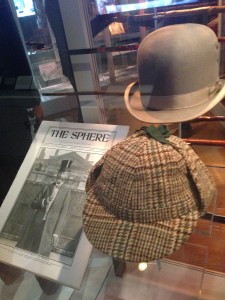 This whole exhibit is about Sherlock Holmes and getting an understanding of how that funny brain of his worked, of learning about where he lived and seeing the many ways his character has been interpreted all around the world and in various mediums from books and radio to film. There were times, I admit, that I almost forgot that he is a fictional character. But can you blame me? Walking through the exhibit, seeing the artefacts and displays, Holmes had come to life for me. The exhibit is beautifully done, it encapsulates the essence of a brilliant man who, as their tag line says, never lived and will never die.
This whole exhibit is about Sherlock Holmes and getting an understanding of how that funny brain of his worked, of learning about where he lived and seeing the many ways his character has been interpreted all around the world and in various mediums from books and radio to film. There were times, I admit, that I almost forgot that he is a fictional character. But can you blame me? Walking through the exhibit, seeing the artefacts and displays, Holmes had come to life for me. The exhibit is beautifully done, it encapsulates the essence of a brilliant man who, as their tag line says, never lived and will never die.
The Museum of London’s Sherlock Holmes: The Man who Never Lived and Will Never Die exhibit will run from October 17 2014 to April 12 2015. Tickets are £12 and £10 for concession. There is also a brilliant little shop at the end full of more Holmesian delights. Also be sure to check out the book Sherlock Homles: The Man Who Never Lived and Will Never Die edited by Alex Werner. We’ve reviewed it, which you can read here.
Many thanks to The Museum of London for inviting us to the preview!
There are other Sherlock Holmes related events on at the Museum and are available for booking, check out the Sherlock Holmes event series on the Museum’s webpage for more information and booking.

Sora is a London based graphic design artist for The Baker Street Babes. She’s also a traveler with The Nerdventurists, travel with a nerdy twist.
You can follow her on twitter @MDSora.
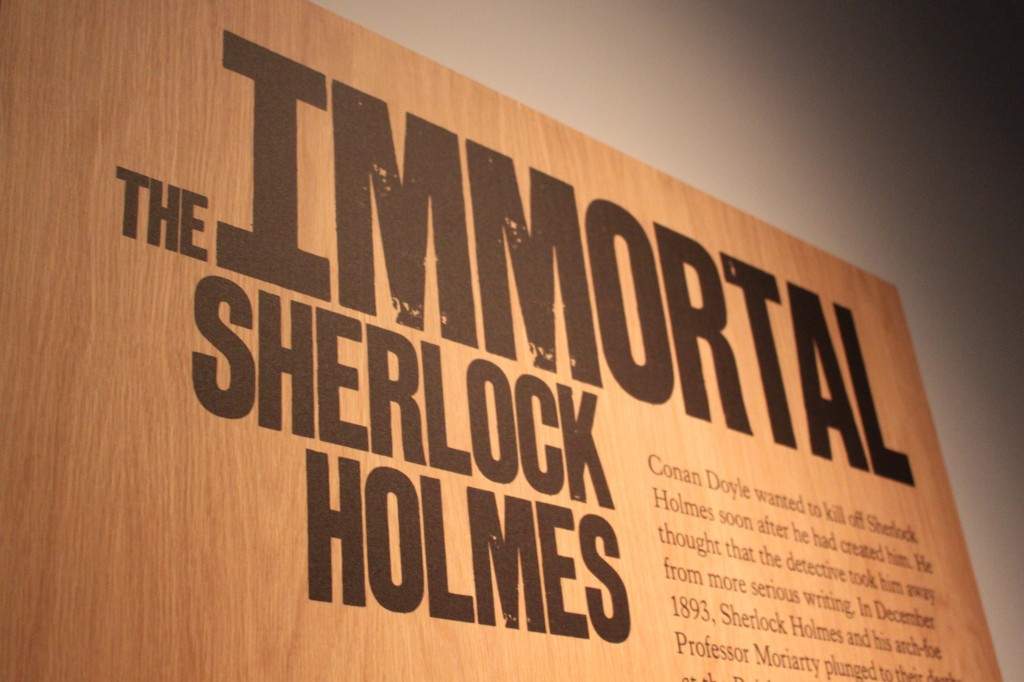
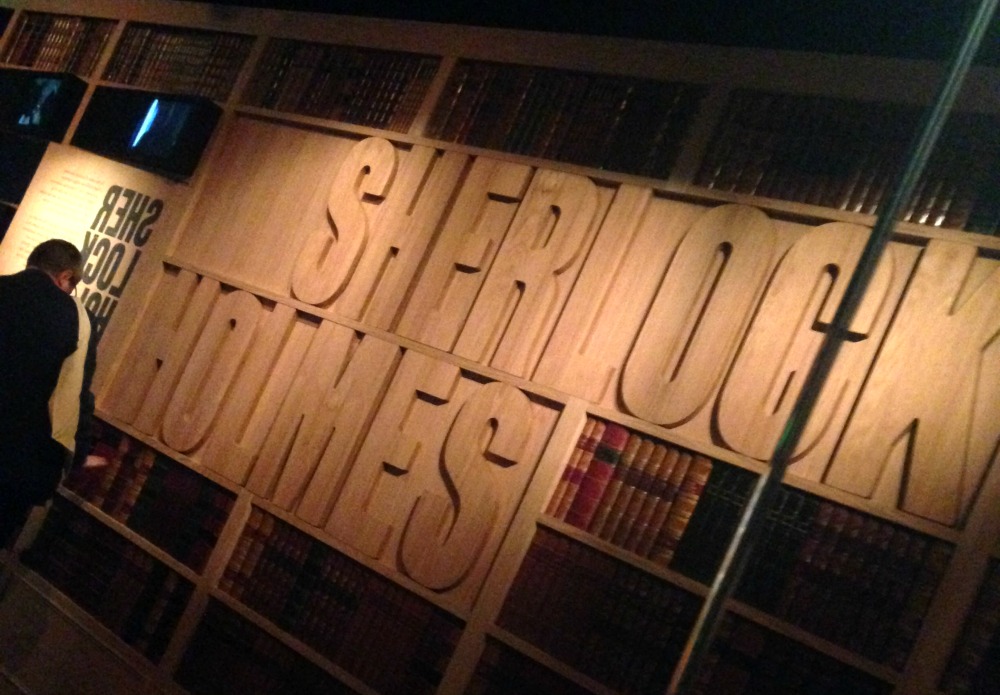
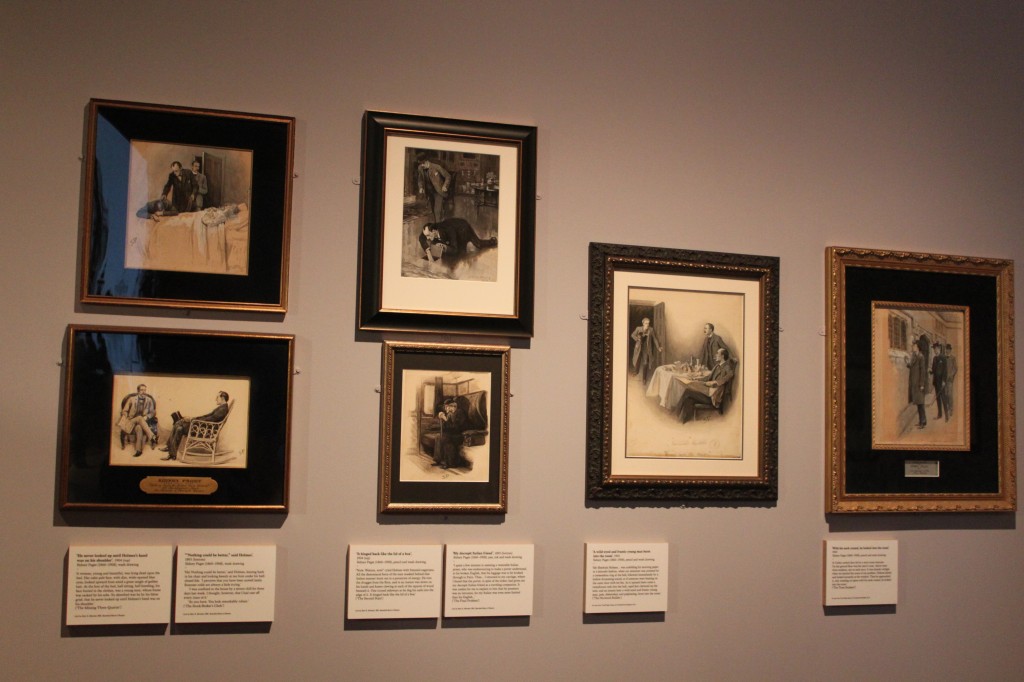
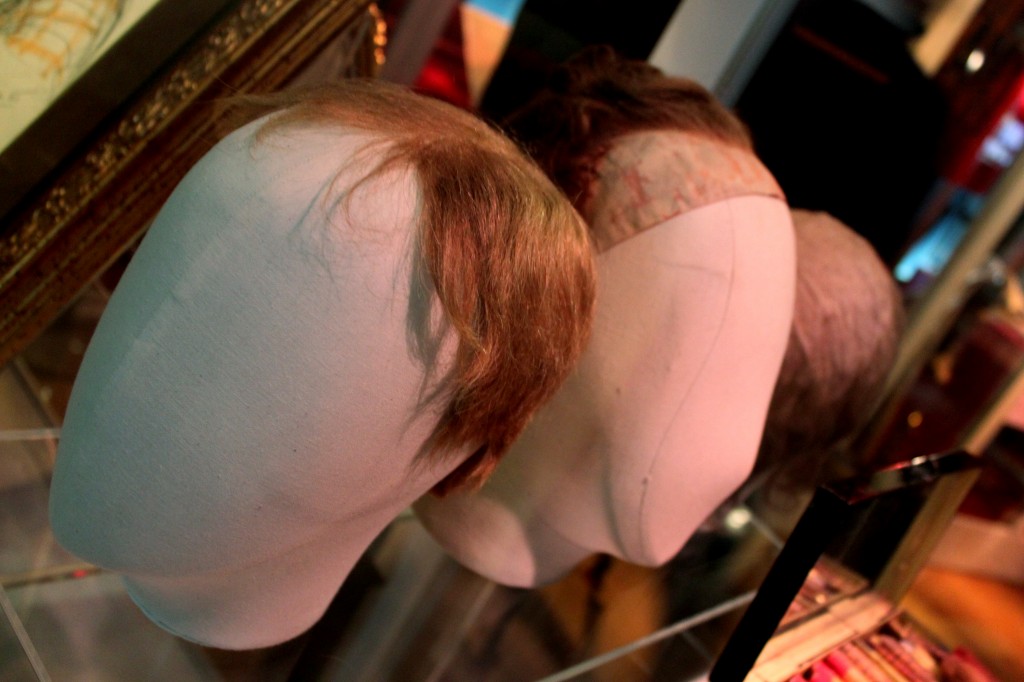

This is a cracking exhibition and I plan to go again, and again (well at least three times) until I’ve seen everything.
I’ve JUST been given Mr. Werner’s edited book and am having a pretty grand time reading it.Owning the catalogue is quite clearly desirable as well as NECESSARY. How may I get one?
Admiringly awaiting your reply, I am
Eleanor Earle
11 George Street
Barrington, Rhode Island 02806 (eearle10552gmail.com)